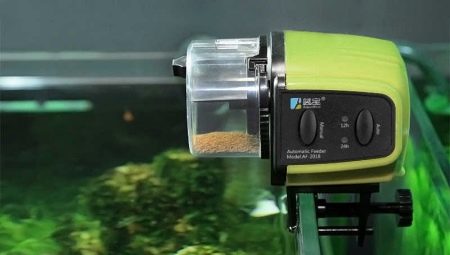Aquarium feeders are a convenient and practical device and allow you to streamline the procedure for feeding aquarium fish. With their help, it is possible to accustom the inhabitants of the reservoir to strictly observe the regime and eat in a strictly designated place for this.
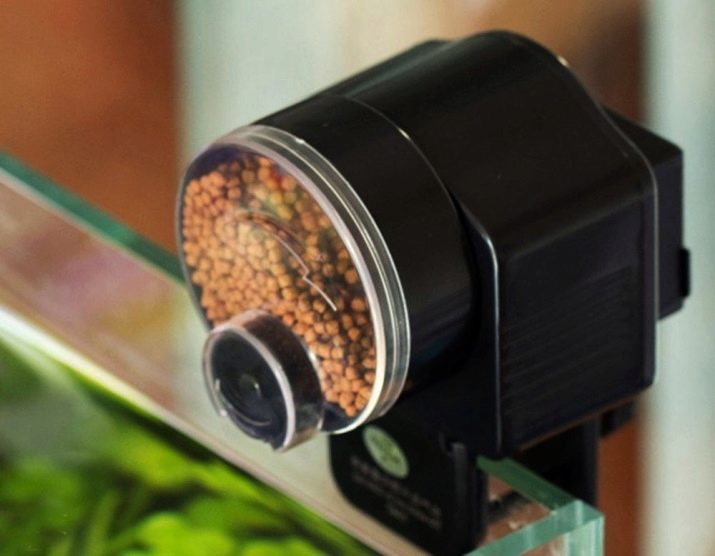
Features and purpose
The debate about whether fish really need a feeder has been going on for many years. Some aquarists insist that the device is simply necessary and thanks to it, cleanliness and order always reign in the aquarium. Others, on the contrary, are convinced that feeding troughs are not a matter of prime necessity and do well without them.. Therefore, the issue of purchasing this device depends on the personal preferences of the owner of the aquarium.
So, the fish feeder is a rather simple construction, the most elementary sample of which consists of a limiting contour and a fine mesh, with its help the food does not settle on the bottom of the aquarium and does not rot in the corners. This helps to maintain the purity of the aquarium water, and also prevents its clouding and the appearance of an unpleasant odor.
Besides, particles of live food are much heavier than water, so they strive to sink to the bottom of the tank. Because of this, especially slow fish that do not know how to eat from the bottom often remain hungry. The net also reliably holds feed and enables timid individuals to fully eat.

Although the feeders are not equipped with a net, although they do not hold the uneaten feed, they contribute to its subsidence in a strictly defined place.This allows catfish not to scour the bottom in search of food, but to purposefully swim to the desired areas and eat calmly.
Moreover, the use of a feeder solves the problem of feeding fish during the vacation of the owners. However, for these purposes more sophisticated electronic automatic devices are used, which in the absence of humans will feed the inhabitants of the aquarium at a strictly defined time.
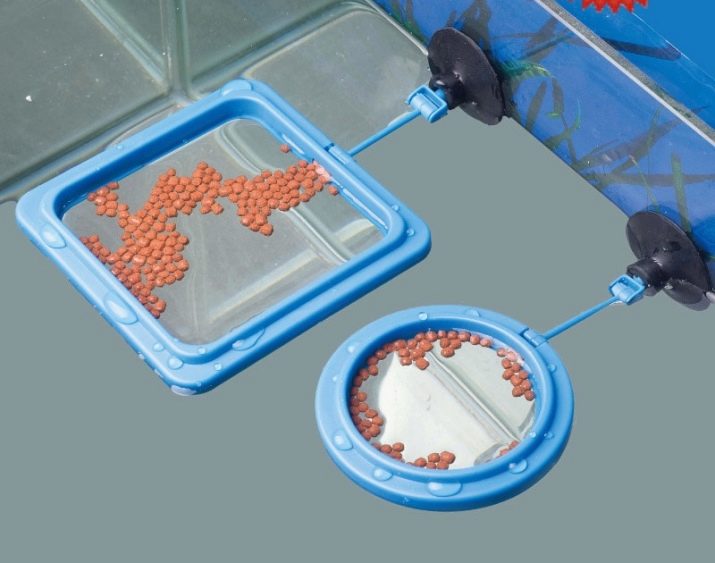
Varieties
The main criterion for the classification of aquarium feeders is the principle of action. On this basis, two types of models are distinguished.
Floating feeders
Such devices are designed very simply and often have a makeshift design. They are attached to one of the walls of the aquarium using suction cups. They are a perimeter fence, which does not allow the feed to spread out in different directions. While feeding fish with live food, a cone with a net is inserted inside the frame, into which worm bugs are placed. Fish freely swim to the feeder and freely devour animals.
The advantage of floating models is the simplicity of design, minimal risk of breakage and low cost, and their disadvantages include their inefficiency in case of lowering the water level in the aquarium. The latter circumstance obliges the owners to constantly check that the feeder is in the water in a free-floating state, and does not roll on its side when crushing the aquarium.
However, this problem is solved by installing a special bracket that slides up and down when the water level changes. Such feeders do not need constant monitoring of the liquid and serve excellently for a long time.
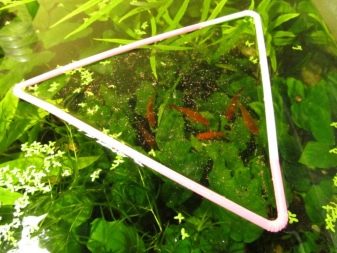
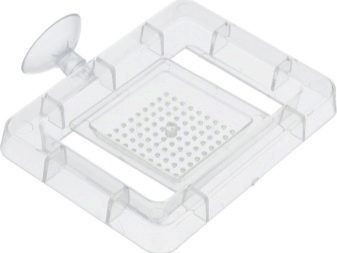
There are situations when it is not possible to purchase a ready-made feeding trough, then models made by hand will come to the rescue. The easiest option will be a foam frame cut from a 1.5 cm thick sheet
The advantage of this design will be a penny cost and the fact that even such a simple device can satisfactorily cope with its duties. The disadvantages of foam models include a short service life and a quick loss of appearance, due to the tendency of the material to absorb dirt. Somewhat more durable are rubber feeders, which can be made by bending a rubber tube with a cross section of 1 cm into a ring.
Such designs stay perfectly on the water, resistant to mechanical damage. The main thing in their manufacture is to fix the ends well, otherwise water will fall into the tube cavity and the structure will sink.
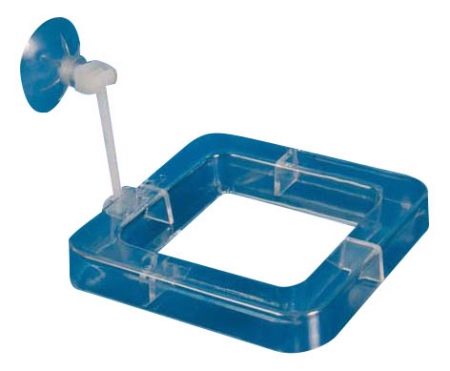
Auto Models
An auto-feeder is an electronic device that allows you to feed fish automatically. Such models are vital for communities whose owners have been away from home for more than 12 hours or have too many aquariums that require constant attention and care. Besides, automation of the nutrition process is indispensable when rearing young animalswhich should be fed at short intervals. Structurally, automatic feeders consist of an engine, a sealed compartment, a timer with an electronic unit, a niche for the battery and the control unit.
The principle of operation of automatic feeders is quite simple and looks as follows:
- feed is poured into a special compartment located above the water level;
- the timer is programmed for a certain time;
- at the right time, a portion of food is thrown out of the perforated drum;
- after emptying, the drum scrolls and is again filled with feed.
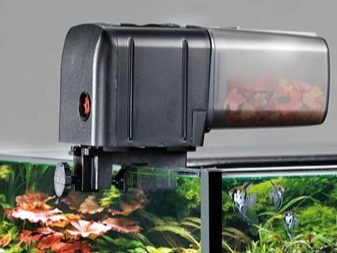
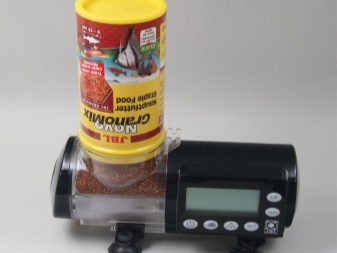
To adjust the amount of feed mixture, a special plate is used that moves back and forth, thereby reducing or increasing the volume of the drum. However, drum specimens are the simplest construction. In addition to them, there are also screw and disk models, as well as designs with a damper.In screw feeders, the amount of feed is measured using a worm shaft, and in products with a shutter, the feed is dispensed dosed out into the aquarium during its opening. Disk samples consist of several compartments that alternately throw away a portion of food.
Used as a power source for automated feeders mains or AA batteries. The cost of automatic feeders varies from 1.5 to 5 thousand rubles and depends on the functionality and volume of the models. The advantages of electronic copies include the complete automation of the fish feeding process, which allows you to be absent at home for more than three days.
Among the shortcomings note the high cost and inability to use live and frozen feed. In addition, with a long absence of the owner, the fish will be forced to eat only one type of food. In order for the stock to be healthy and develop correctly, the fish diet should be more saturated and varied.
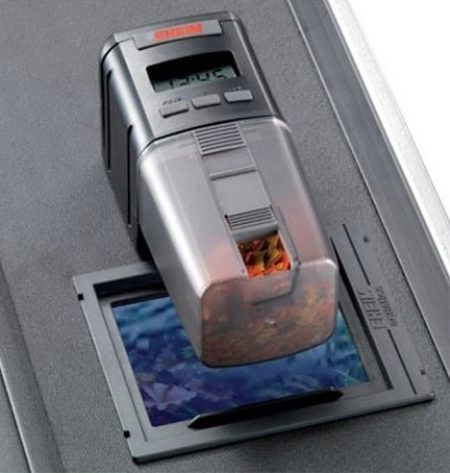
How to choose?
When choosing an aquarium feeder it is necessary to focus on such an important point as the frequency of feeding the livestock. Modern automatic models are capable of being programmed to dispense food three or more times a day. In addition, there are options that begin to "feed" the fish only after a certain period. therefore if the owner is absent at home for 6-8 hours, then the best option would be a simple electronic model with batteries.
In the case of a longer absence, you need to purchase feeders that are powered from the network and capable of stably delivering food for two months. Such samples are equipped with a capacious container and are quite expensive.
If the owners are at home and have the ability to feed the fish on their own, then it makes no sense to purchase a feeder. You can limit yourself to a floating factory or homemade device.
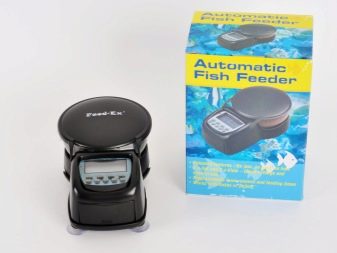
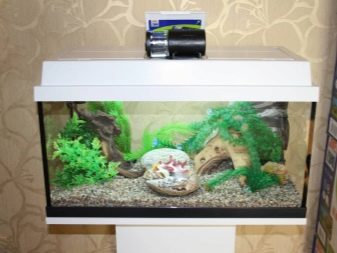
Where to place?
Correct positioning of the feeder makes it possible to feed the fish as comfortable and safe as possible. So, regardless of the power and type of construction, the feeders should be installed away from the aquarium's filtration and aeration systems.
Otherwise, the feed will be washed off by the current that creates the filter, and be treated in places that are inconvenient for fish. As a result, part of the feed will settle on the road and begin to rot, and the other part will be dispersed throughout the aquarium, which will not allow the fish to fully eat. Besides, when installing automatic feeders, operating from the network, it is necessary to consider the availability of outlets.
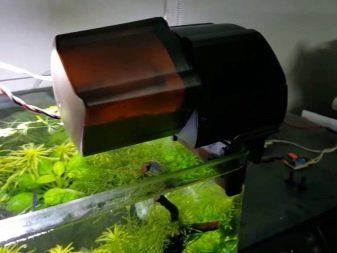
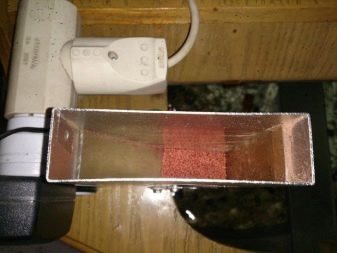
How to use?
Before using the automatic feeder, you must carefully read the instructions.
- Most models are very easy to program, adjusting them to the right amount of feedings will not be difficult. Many standard models are designed for 60 feedings, which allows you to accurately calculate the amount of feed.
- Immediately after purchase, it is recommended that you test the product for several days. And if there are no malfunctions during this period, then you can run the feeder into constant use.
- Periodically, the product should be removed from the water and cleaned of algae and feed residues. This eliminates the risk of mold and extends its life.
- To prevent clumping of feed, some aquarists connect a compressor to the feeder, which blows the granules and prevents them from sticking together.
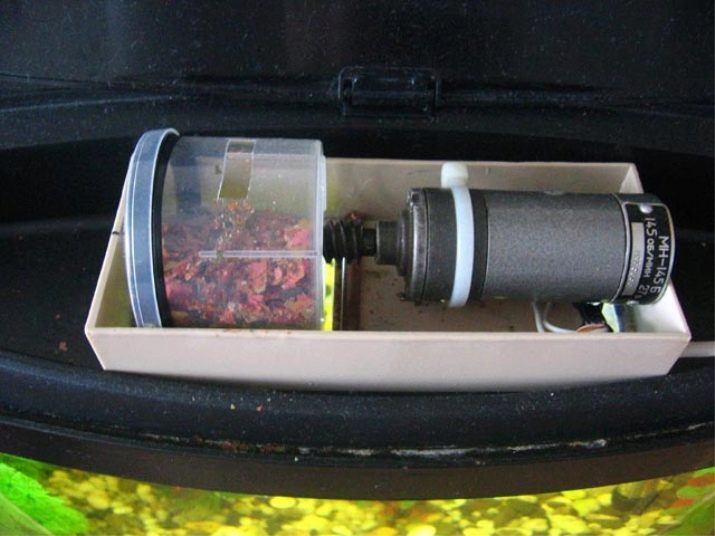
Even if the feeder works flawlessly and has proven itself only on the positive side, you should not leave the fish alone for too long. This is due to the fact that any, even the most reliable mechanism can break, and the livestock will die from hunger. It is better to ask someone once a week to check the operation of automatic devices. So, the owner will be calmer, and the fish will remain safe and sound.
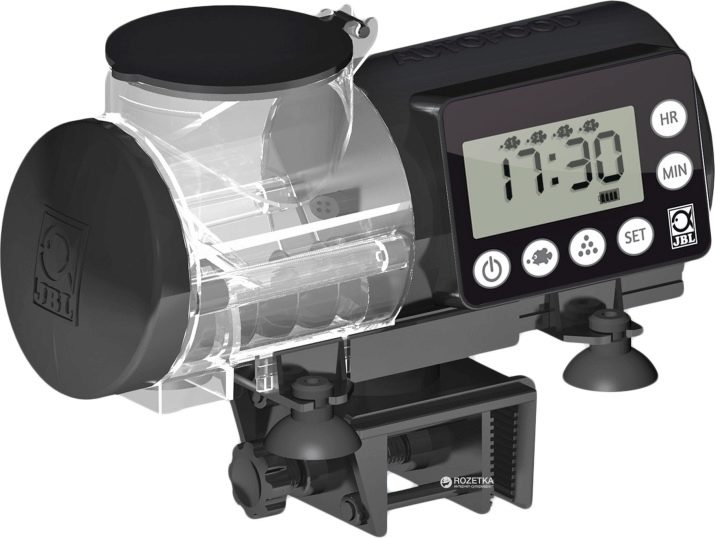
Overview of the automatic feeder for aquarium fish Auto Food P-01 see below.
